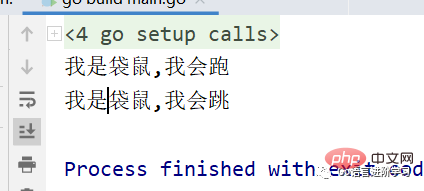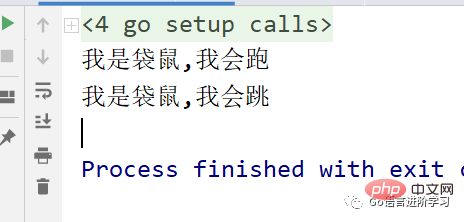
L'interface ici n'est pas le genre d'interface qui est une machine à sous.
Dans diverses langues, lorsque des interfaces sont mentionnées, elles font généralement référence à une spécification, puis des objets spécifiques implémentent les détails de cette spécification.
Les interfaces utilisées dans cet article sont principalement des interfaces de contraintes et une interface de stockage.
Remarque :
Dans Go, une interface est un type, un type abstrait, elle n'a que méthodes, n'a pas d'attributs .
Quand on parle de structures, la structure des bases du langage Go (Spring), la structure des bases du langage Go (Summer), la structure des bases du Langue Go (Automne), a mentionné le concept d'héritage, Go complète l'héritage à travers des structures.
//车
type Car struct {
Brand string //车品牌
CarNum string //车牌号
Tyre int //轮胎个数
}
//给车绑定一个方法,说明车的基本信息
func (this *Car) carInfo() {
fmt.Printf("品牌:%s,车牌号:%s,轮胎个数:%d\n", this.Brand, this.CarNum, this.Tyre)
}La structure de la voiture a quatre attributs et une méthode pour afficher les informations sur la voiture (carInfo). <br/>
<br/>
//宝马车
type BMWCar struct {
//*Car和Car基本没有区别,一个存的是整个结构体,一个存的是结构体地址,用法大同小异
*Car //这就表示继承了Car这个结构体
}//比亚迪车
type BYDCar struct {
*Car
}func main() {
//一个宝马对象
var bmw1 = BMWCar{&Car{
Brand: "宝马x8",
CarNum: "京666",
Tyre: 4,
}
}
//一个比亚迪对象
var byd1 = BYDCar{&Car{
Brand: "比亚迪L3",
CarNum: "京111",
Tyre: 4,
}
}
//因为 BMWCar 和 BYDCar 都继承了Car,所以都有carInfo这个方法
bmw1.carInfo()
byd1.carInfo()
}
通过回顾,我们可以发现,车,应该作为一个基本的概念。<br/>
上述Car结构体似乎显示了车的属性,其实是不太对的。
车就是一个抽象的概念,电瓶车是车,小轿车也是车,大卡车也是车。
这些车至少有一个统一的功能,那就是跑,但是像几个轮胎了,什么品牌了。
应该是属于自己的,不再是属于Car这个抽象的概念中了,所以,这时候用接口会更好。
<br/>
type Car interface {
//车会跑
Run(speed int)
//车需要加油
Refuel(oil int)
//车需要转弯
Wheel(direction string)
}假设车,至少有这三个动作,不管任何结构体,只要实现了Car里面的所有方法,就代表它一定是一个车。<br/>
<br/>
//宝马车
type BMWCar struct {
Owner string //车主
Brand string //车品牌
CarNum string //车牌号
}
//构造方法
func NewBMWCar(owner string, brand string, carNum string) *BMWCar {
return &BMWCar{Owner: owner, Brand: brand, CarNum: carNum}
}
func (this *BMWCar) Run(speed int) {
fmt.Printf("我是 %s,我的车是 %s,我车牌号为 %s,我正在以 %d 速度行驶\n", this.Owner, this.Brand, this.CarNum, speed)
}
func (this *BMWCar) Refuel(oil int) {
fmt.Printf("老板,加%d升油\n", oil)
}
func (this *BMWCar) Wheel(direction string) {
fmt.Printf("我正在%s转弯\n", direction)
}<br/>//电瓶车
type Electromobile struct {
Owner string //车主
Brand string //车品牌
}
func NewElectromobile(owner string, brand string) *Electromobile {
return &Electromobile{Owner: owner, Brand: brand}
}
func (this *Electromobile) Run(speed int) {
fmt.Printf("我是 %s,我的车是 %s,我正在以 %d 速度行驶\n", this.Owner, this.Brand,, speed)
}
func (this *Electromobile) Refuel(oil int) {
fmt.Printf("你妹的,你电动车加啥油...\n")
}
func (this *Electromobile) Wheel(direction string) {
fmt.Printf("我正在%s转弯\n", direction)
}这里是有区别的,电瓶车没有属性CarNum,但是仍然实现了Car接口的所有方法,所以电瓶车在代码上,仍然是车。
func main() {
var 张三的车 Car
张三的车 = NewBMWCar("张三", "宝马6", "京666")
张三的车.Run(80)
张三的车.Refuel(20)
张三的车.Wheel("左")
var 李四的车 Car
李四的车 = NewElectromobile("李四", "小刀电动车")
李四的车.Run(40)
李四的车.Refuel(0)
李四的车.Wheel("左")
}第2行代码和第8行代码,变量类型是Car接口类型,但是在赋值时,确是其他类型。<br/>
Go是强类型语言,为什么类型不一致,还可以赋值,那执行结果会出问题吗???

但是我们发现执行结果是没问题的。<br/>
Mais pourquoi une affectation peut-elle être effectuée et une erreur signalée à chaque fois si les types de variables sont incohérents ?
Notre code ci-dessus peut confirmer que les voitures BMW et voitures à batterie sont entièrement réaliséesVoitureCar接口里面所有的方法。
所以可以理解为CarToutes les méthodes de l'interface.
Cela peut donc être compris comme <br/>,一个是Jumper。
<br/>
func main() {
var runner Runer
var jumper Jumper
runner = &Roo{Name: "袋鼠"}
jumper = &Roo{Name: "袋鼠"}
runner.Run()
jumper.Jump()
}Roo既然实现了两个接口,自然两个接口都可以接收Roo这个结构体。

<br/>
接口嵌套这个有点像组合,比如有跑,跳,吃等这些操作。
例如一个动物,因该是要有这些操作的,那这个动物应该也是一个接口。
并且把这些动作都拿过来才对。
<br/>
//跑接口
type Runer interface {
Run()
}
// 跳接口
type Jumper interface {
Jump()
}
//动物接口,继承了 跑 和 跳
type Animal interface {
Runer
Jumper
}//袋鼠结构体,实现了跑和跳
type Roo struct {
Name string
}
func (this *Roo) Jump() {
fmt.Println("我是袋鼠,我会跳")
}
func (this *Roo) Run() {
fmt.Println("我是袋鼠,我会跑")
}func main() {
var animal Animal
animal = &Roo{Name: "袋鼠"}
animal = &Roo{Name: "袋鼠"}
animal.Run()
animal.Jump()
}
Ci-dessus, nous avons appris les interfaces de base de Go, principalement la différence entre interfaces et héritage, une structure implémente plusieurs interfaces , Imbrication d'interfaces .
Ce n'est peut-être pas facile à comprendre, mais il faut l'essayer et persévérer !
Ce qui précède est le contenu détaillé de. pour plus d'informations, suivez d'autres articles connexes sur le site Web de PHP en chinois!
 Utilisation du mot-clé Type dans Go
Utilisation du mot-clé Type dans Go
 Comment implémenter une liste chaînée en go
Comment implémenter une liste chaînée en go
 Que sont les logiciels de programmation en langage Go ?
Que sont les logiciels de programmation en langage Go ?
 Comment apprendre le langage go à partir de 0 bases
Comment apprendre le langage go à partir de 0 bases
 Quelles sont les méthodes pour implémenter la surcharge d'opérateurs en langage Go ?
Quelles sont les méthodes pour implémenter la surcharge d'opérateurs en langage Go ?
 Quels sont les opérateurs en langage Go ?
Quels sont les opérateurs en langage Go ?
 plugin tencent qqmail
plugin tencent qqmail
 Comment utiliser la fonction moyenne
Comment utiliser la fonction moyenne